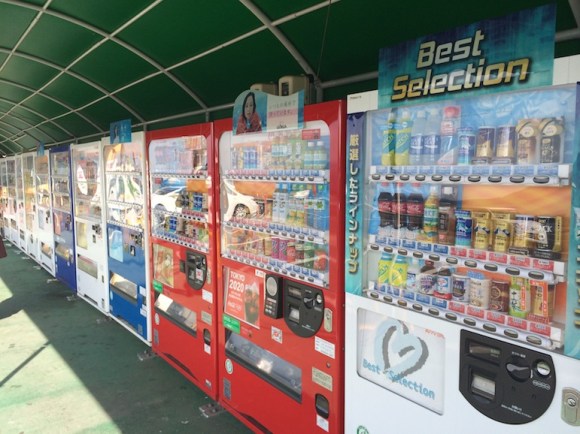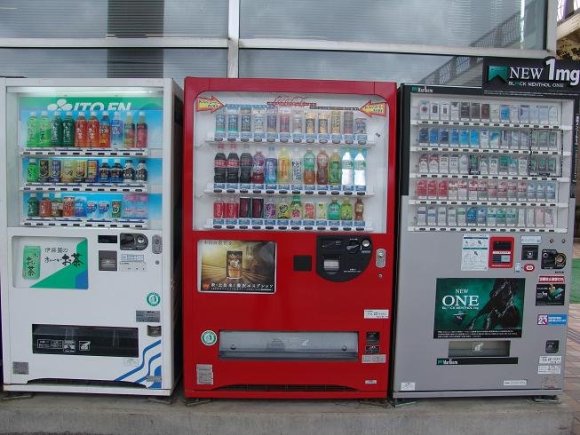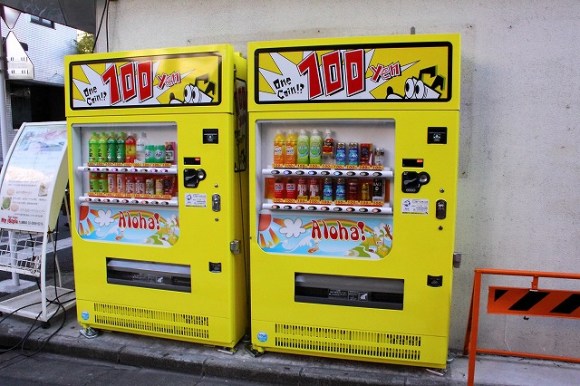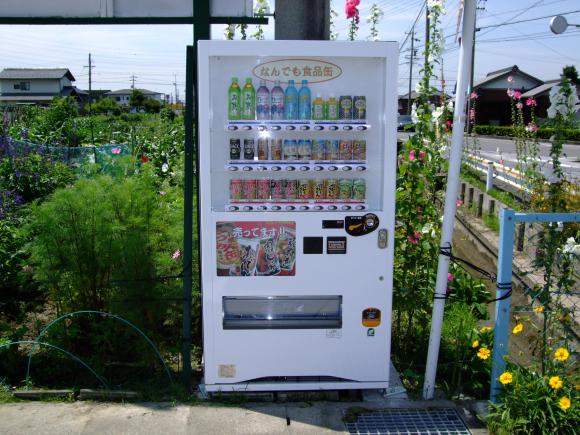Vending machines are ubiquitous in Japan. You’ll find them on most street corners, outside office blocks, lined up at bus stops, and even on the top of Mount Fuji. Prices vary, but the lowest you’ll find in Tokyo is usually the ‘one coin’ machines where everything costs just 100 yen (US$0.98). How can they sell them so cheap? Are they actually profitable? The answer is yes, and many ordinary business-minded folks are taking advantage of the opportunities they offer to put away a nice chunk of cash each month.
Owning vending machines is one of the simplest and most hands-off side businesses you could think of. All you need is somewhere to install it, and it’ll diligently work away earning money for you day and night while you do pretty much nothing. Just sticking one in front of your house is like putting a bank box out there for others to deposit money into.
Many vending machines are owned by beverage companies such as Ito En, Asahi, or Coca Cola, and landowners can enter into a contract with them to place the machine on their land, receiving either a land rental fee or a cut of the profits from drinks sold. In this case the only thing you have to worry about is the electricity bill, and otherwise it’s a pretty reliable, risk-free investment.
However, other people looking to earn a bit of extra cash are taking a more independent approach. And apparently right now is the time to start your side business as, believe it or not, the increase in consumption tax has actually been a blessing in disguise for these entrepreneurs.
Mr. C (46), who earns money from his vending machines alongside his job running a restaurant, explains the system. “There’s a method where you contract with a distributor for the beverage company, but that’s no fun because you only get around 10 yen (US$0.10) profit from each drink. What I’m doing is buying and installing ‘independent’ vending machines myself.”
- Higher tax is actually a good thing?!
Consumption tax in Japan was raised from 5 percent to 8 percent at the beginning of April, meaning that not only is everything now just that little bit more expensive, but it’s also all in awkward amounts like 687 yen meaning your pockets are always filled with annoying bits of change. However, since vending machines don’t accept 1 yen coins, beverage companies have raised prices in their machines by 10 yen, for example from 120 yen to 130. According to Mr. C, this has been favorable for independents like him. “If there’s a fixed-price company vending machine nearby, then for me to compete by selling at 100 yen means that my stuff flies off the shelves.”
- How to make it work for you
The essential things you need to consider when looking to install your first vending machine are purchasing the machine itself, purchasing the stock, and finding a place to put it.
“The main point is how cheaply you can purchase the plain white vending machines that in the industry lingo are called ‘beppin-san’ (beppin can mean a beauty, or an item of special quality). Buying one new will set you back 1.2 million yen (US$11,700), but I go around asking appliance shops if they have any good but second-hand machines from stores that have gone out of businesses and so on. Rather than the expensive slim-types, a cheaper standard type (holds 360 bottles) that is three years old can be bought for around 200,000 to 300,000 yen ($1,960-2,950), and you can use it for at least another five years.” Since they’re second-hand, sometimes these machines will still have old company logos on their sides, but once you’ve purchased one you could cover it up with your own ‘one coin’ sign.
“I buy my stock from cash wholesalers for 38 to 60 yen (US$0.37-0.59) per bottle. I choose my lineup based on an average gross profit (sales revenue minus purchase cost) of 50 yen ($0.49) per bottle. The machine runs 24 hours a day so the electricity bill is around 5,000 yen ($49) per month.”
The national average sales for a vending machine is almost 40,000 yen (US$390) per month. If it’s in a particularly good place where you can expect a consistent flow of people, such as near a station on a commuting route or by a park, then it can be as much as 500,000 yen ($4,900)!
That all sounds too good to be true – are there any pitfalls?
The most important thing you need to consider is where to place your machine, as this can be the difference between a nice wad of cash in your pocket and having to actually fork out your own hard earned money just to keep it running.
Mr. C advises that “it’s best if your own house is in one of these ‘good spots’, but if this isn’t the case then you can ask the owner of a suitable area to put it on his or her land. In these situations it’s common to pay a leasing fee to place the machine of 10,000 yen (US$98) per month, or hand over 30% of the profits. If you have three machines in a place where there are a lot of people passing by, then you can aim for a minimum income from your side business of 200,000 yen ($1,965) per month. Of course, the worst thing you can do is place your machine in a place where it can’t sell the drinks. If your monthly sales drop to 20,000 yen ($196), then rather than turning a profit you’ll be in the red due to the depreciation of the machine, the cost of buying stock, and paying for land rental and electricity usage.”
Another thing is to be careful when ordering your stock, and be aware of what will and won’t sell. Mr. C experienced this himself the hard way: “it’s also tough if you make a mistake when selecting your products. I bought some non-branded juice which seemed like a great idea because it was so cheap, but it didn’t sell at all and with it nearing its expiration date I found myself stuck with drinking this disgusting juice every day myself!”
So for anyone in Japan looking to bring in an additional cash flow, this could be your chance! I know Japan seems like it’s got plenty of vending machines already, but I’m sure there’s always room for more.
Source: Shueisha News
Header Image: My Small World
Insert Images: Yu-sa, Oyama News, Enndoukenntiku





 Japanese stationery vending machine at Haneda Airport is a great option for last-minute souvenirs
Japanese stationery vending machine at Haneda Airport is a great option for last-minute souvenirs “Why Japan has so many vending machines” video makes some good points, but misses key factors
“Why Japan has so many vending machines” video makes some good points, but misses key factors Weird Japanese vending machine comes with a heartwarming twist
Weird Japanese vending machine comes with a heartwarming twist Are blank vending machines the future in Japan?
Are blank vending machines the future in Japan? Japan’s vending machines are no match for counterfeit coins
Japan’s vending machines are no match for counterfeit coins Starbucks Japan ready to get Year of the Horse started with adorable drinkware and plushies【Pics】
Starbucks Japan ready to get Year of the Horse started with adorable drinkware and plushies【Pics】 7 great places to see Mt. Fuji from without having to climb it
7 great places to see Mt. Fuji from without having to climb it We found possibly the quietest Japanese-style hotel in Tokyo’s bustling Shinjuku district
We found possibly the quietest Japanese-style hotel in Tokyo’s bustling Shinjuku district Survey finds more than 70 percent of Japanese children have an online friend
Survey finds more than 70 percent of Japanese children have an online friend New Japanese menstrual product seeks to help women spot unidentified iron deficiencies
New Japanese menstrual product seeks to help women spot unidentified iron deficiencies Beautiful Starbucks in Kyoto blends into its traditional landscape in more ways than one
Beautiful Starbucks in Kyoto blends into its traditional landscape in more ways than one How much difference does the choice of mold make in fermenting food?
How much difference does the choice of mold make in fermenting food? Japanese group to hold fashion show of colostomy bags and other stoma equipment in Paris
Japanese group to hold fashion show of colostomy bags and other stoma equipment in Paris Japan’s oldest largetooth sawfish in captivity back on display in Mie Prefecture
Japan’s oldest largetooth sawfish in captivity back on display in Mie Prefecture Large amount of supposed human organs left in Osaka marketplace
Large amount of supposed human organs left in Osaka marketplace Lacquerware supplier to emperor of Japan and Pokémon team up for new tableware
Lacquerware supplier to emperor of Japan and Pokémon team up for new tableware Japan may add Japanese language proficiency, lifestyle classes to permanent foreign resident requirements
Japan may add Japanese language proficiency, lifestyle classes to permanent foreign resident requirements 7-Eleven Japan’s ramen-cooking robot whipped us up a bowl of noodles【Taste test】
7-Eleven Japan’s ramen-cooking robot whipped us up a bowl of noodles【Taste test】 Cyberpunk anime meets traditional culture in Ghost in the Shell gold leaf Japanese changing screens
Cyberpunk anime meets traditional culture in Ghost in the Shell gold leaf Japanese changing screens Disillusionment at Tsukiji’s tourist-target prices led us to a great ramen restaurant in Tokyo
Disillusionment at Tsukiji’s tourist-target prices led us to a great ramen restaurant in Tokyo Hello Kitty Choco Egg figures are an adorable trip through three periods of Japanese pop culture【Pics】
Hello Kitty Choco Egg figures are an adorable trip through three periods of Japanese pop culture【Pics】 Starbucks Japan releases new zodiac chilled cup drink for 2026
Starbucks Japan releases new zodiac chilled cup drink for 2026 Japan’s otoshidama tradition of giving kids money at New Year’s gets a social welfare upgrade
Japan’s otoshidama tradition of giving kids money at New Year’s gets a social welfare upgrade 7-Eleven Japan starts new temporary luggage storage service in over 300 branches
7-Eleven Japan starts new temporary luggage storage service in over 300 branches Starbucks teams up with 166-year-old Kyoto doll maker for Year of the Horse decorations【Photos】
Starbucks teams up with 166-year-old Kyoto doll maker for Year of the Horse decorations【Photos】 Tokyo considering law requiring more trash cans following litter increase in heavily touristed area
Tokyo considering law requiring more trash cans following litter increase in heavily touristed area Tokyo’s Tsukiji sushi neighborhood asks tour groups to stay away for the rest of the month
Tokyo’s Tsukiji sushi neighborhood asks tour groups to stay away for the rest of the month Nintendo’s Kirby now delivering orders at Kura Sushi restaurants, but not in Japan
Nintendo’s Kirby now delivering orders at Kura Sushi restaurants, but not in Japan Tokyo event lets you travel back in time, for free, to celebrate 100 years since Showa era start
Tokyo event lets you travel back in time, for free, to celebrate 100 years since Showa era start Sanrio theme park in Japan announces plans to expand into a Sanrio resort
Sanrio theme park in Japan announces plans to expand into a Sanrio resort Stamina-destroying “Paralysis Noodles” are Tokyo’s newest over-the-top ramen innovation
Stamina-destroying “Paralysis Noodles” are Tokyo’s newest over-the-top ramen innovation Survey asks foreign tourists what bothered them in Japan, more than half gave same answer
Survey asks foreign tourists what bothered them in Japan, more than half gave same answer Japan’s human washing machines will go on sale to general public, demos to be held in Tokyo
Japan’s human washing machines will go on sale to general public, demos to be held in Tokyo Japan’s deadliest food claims more victims, but why do people keep eating it for New Year’s?
Japan’s deadliest food claims more victims, but why do people keep eating it for New Year’s? We deeply regret going into this tunnel on our walk in the mountains of Japan
We deeply regret going into this tunnel on our walk in the mountains of Japan Studio Ghibli releases Kodama forest spirits from Princess Mononoke to light up your home
Studio Ghibli releases Kodama forest spirits from Princess Mononoke to light up your home Major Japanese hotel chain says reservations via overseas booking sites may not be valid
Major Japanese hotel chain says reservations via overseas booking sites may not be valid Put sesame oil in your coffee? Japanese maker says it’s the best way to start your day【Taste test】
Put sesame oil in your coffee? Japanese maker says it’s the best way to start your day【Taste test】 No more using real katana for tourism activities, Japan’s National Police Agency says
No more using real katana for tourism activities, Japan’s National Police Agency says Starbucks Japan reveals new sakura drinkware collection, inspired by evening cherry blossoms
Starbucks Japan reveals new sakura drinkware collection, inspired by evening cherry blossoms Updated cherry blossom forecast shows extra-long sakura season for Japan this year
Updated cherry blossom forecast shows extra-long sakura season for Japan this year Will we win a 75,000-yen tub of caviar from this Japanese vending machine?
Will we win a 75,000-yen tub of caviar from this Japanese vending machine? Send a free drink to a friend with Japan’s newest coinless vending machines【Video】
Send a free drink to a friend with Japan’s newest coinless vending machines【Video】 New vending machines at Shinjuku Station emit scent, play projection mapping with your purchase
New vending machines at Shinjuku Station emit scent, play projection mapping with your purchase Japanese vending machine is the first of its kind, operated by a local business
Japanese vending machine is the first of its kind, operated by a local business Taste-testing Japan’s beef tongue/gacha beef vending machine in Sendai【Taste test】
Taste-testing Japan’s beef tongue/gacha beef vending machine in Sendai【Taste test】 Creative problem solving: Vending machine dispenses cans with 5 yen coins taped to them
Creative problem solving: Vending machine dispenses cans with 5 yen coins taped to them Japanese vending machine serves up Wagyu beef steaks in the countryside
Japanese vending machine serves up Wagyu beef steaks in the countryside In Search of Osaka’s 11 Cent Vending Machine
In Search of Osaka’s 11 Cent Vending Machine Japanese vending machines now sell pearl jewellery
Japanese vending machines now sell pearl jewellery Should you trust these suspicious-looking Japanese vending machines?
Should you trust these suspicious-looking Japanese vending machines? Vending machine that serves handmade gyoza found in Yokohama!
Vending machine that serves handmade gyoza found in Yokohama! Tokyo vending machine sells beautiful shugifukuro money envelopes for wedding and other gifts
Tokyo vending machine sells beautiful shugifukuro money envelopes for wedding and other gifts We buy oysters from a Japanese vending machine
We buy oysters from a Japanese vending machine Try-your-luck vending machine proves it doesn’t always pay to take a gamble
Try-your-luck vending machine proves it doesn’t always pay to take a gamble Another Amazing Vending Machine From Japan! But This One’s No High-Tech Gadget
Another Amazing Vending Machine From Japan! But This One’s No High-Tech Gadget
Leave a Reply